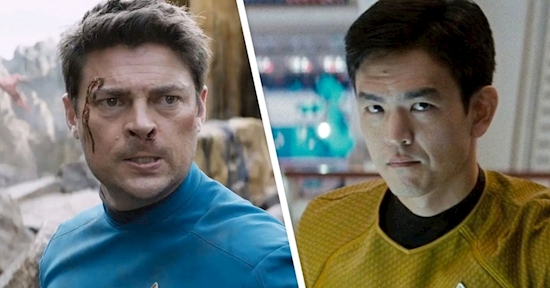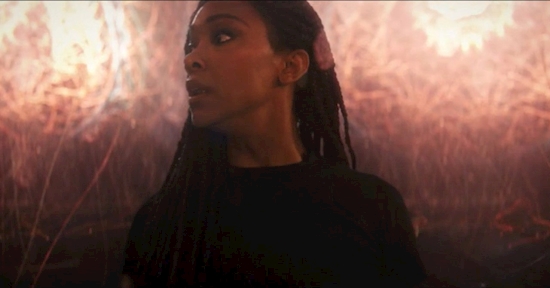Star Trek: TOS – The original five-year mission, boldly going where no one had gone before
 What can be written about Star Trek that hasn’t already been a million times before? You’re probably aware that the original adventures of the crew of the starship Enterprise was a manifestation of creator Gene Roddenberry’s positive, quasi-utopian vision of the future; the 1960s counterculture philosophy of “Make Love Not War” is pervasive throughout these roots of the Star Trek universe.
What can be written about Star Trek that hasn’t already been a million times before? You’re probably aware that the original adventures of the crew of the starship Enterprise was a manifestation of creator Gene Roddenberry’s positive, quasi-utopian vision of the future; the 1960s counterculture philosophy of “Make Love Not War” is pervasive throughout these roots of the Star Trek universe.
And you probably realize that the Star Trek original series was notable for its groundbreaking first within greater American pop culture. Not talking stuff like The First Interracial Kiss On Television (“Plato’s Stepchildren”), but rather the show’s status as the USA’s first-ever cult TV show. Surely you’ve heard of the letter-writing campaign that saved season three, but how many times since has a similar effort been undertaken, much less worked, even with 21st-century technology? Also, what show can said to have been resurrected first in animated form? What TV cast has ever made the direct leap from TV to film, much less gone on to do six movies in all?
Naturally, shortly after considering just how popular the humble Star Trek original series became, the question becomes: “Why did Star Trek become the pop culture powerhouse it is today?”
Like an insane god born of a nebula, Star Trek was born in perfect storm conditions. With the TV finally firmly affixed as the American family’s #1 source of entertainment, television networks depended on as broad an appeal as possible. The international cast spoke to the 1960s pleas for equality, and the Enterprise crew emphasized on all “strange new worlds” that they were on a “mission of peace” (on a starship armed with starship-crippling phasers and photon torpedoes, mind you).
Tom Hardy makes too much sense as a young Jean-Luc Picard
Source: redshirtsalwaysdie.comStar Trek: Discovery: Rachael Ancheril's mom helped save Star Trek
Source: redshirtsalwaysdie.comStar Trek Actors Karl Urban and John Cho Reunite in New Photo
Source: comicbook.comStar Trek Discovery Season 3's Many Voyager Parallels Explained
Source: screenrant.comDiscovery Season 3 Has Solved Its Biggest Star Trek Problem
Source: screenrant.comStar Trek: Vulcans Were On Earth Before Picard's First Contact
Source: screenrant.comStar Trek: Discovery Reveals Key Change to Starfleet's Mission
Source: comicbook.comDiscovery's DS9 & Voyager References Make It Star Trek's Biggest Show
Source: screenrant.comDiscovery Season 3 Has Learned From Star Trek's TNG Success
Source: screenrant.comStar Trek: Discovery Reveals The Mirror Universe's 32nd Century
Source: screenrant.comStar Trek Discovery: Every Starfleet & Federation Change In The 32nd Century
Source: screenrant.comStar Trek: TOS' Daystrom Institute Created Discovery's New Computer
Source: screenrant.comStar Trek: Every Pet Kept On A Starship (So Far)
Source: screenrant.comAlex Trebek dead at 80: Celebrities pay tribute to Jeopardy! host
Source: metro.co.ukBook Review: Star Trek Movie Memories by William Shatner
Source: redshirtsalwaysdie.comICYMI: 4 posts Red Shirts Always Die is highlighting this week
Source: redshirtsalwaysdie.comIf you miss Star Trek: The Original Series watch Star Trek Continues
Source: redshirtsalwaysdie.comStar Trek Makes A Major Change To A Fan-Favorite Alien Race
Source: comicbook.comStar Trek: Discovery's New Computer Voice Explained (& Who Plays Her)
Source: screenrant.comStar Trek: Captain Pike's Prequel Was Already Told in Marvel Comics
Source: screenrant.comStar Trek: Strange New Worlds: Paging the Enterprise's next doctor
Source: redshirtsalwaysdie.comBy the same token, note the appeal to traditional values in Captain James T. Kirk (unironically played by a Canadian): A maverick, to be sure, but a good *American* maverick; a maverick for justice like the vigilantes who populated the endless Western series that dominated “wholesome” 1950s/60s TV with actors named Shatner and Nimoy and Kelley. America as an exemplar of Earth culture sneaks its way into Star Trek: The Original Series again and again, playing to at least half an American audience.
By 1968, Star Trek had amassed the original cult audience: Relatively small and high-majority male, for this audience Star Trek wasn’t merely a great show or even their favorite show Star Trek was the pinnacle of American entertainment at that time, if not for all-time. This obsession of a few kept Star Trek: The Original Series reruns in syndication throughout North America straight through to 1979, the release of The Motion Picture, and beyond. Like a bona fide cult, millions upon millions were converted to Star Trek fandom…
Today, Star Trek is a pop culture juggernaut – and that’s all down to this kooky little science-fiction program that NBC didn’t understand, that star William Shatner “did on a lark” (at least according to the SNL iteration of Shatner), that was saved by slavish devotees.
Most Star Trek original series episodes may today seem (and, let’s face it, are) ultra-cheesy today but must be recognized as fundamental to a universe of awesomeness. Plus, 10 or 12 are worth watching…
Star Trek: The Original Series – Cast and crew
Here they are, the trendsetters: The men and women (the miscellaneous and otherly-gendered would be included beginning in the Animated Series) of the starship Enterprise – And for the record, that’s the NCC one seven oh one, no bloody A, B, C or D. Led by the intrepid Captain Kirk, this brightly-garbed posse of explorers would set the mold for the United Federation of Planets crew featured on each ST series, producing archetypes which are echoed in nearly every American space opera-type series or movie of the past half-century.
The influence of the original series’ characters expands even well beyond the visual entertainment world to become infused in Anglo culture itself, with catchphrases and memes infusing the English language itself on a par with DC Comics superheroes and Star Wars. These characters are no mere throwaway pulp-fiction tropes (actually, they kinda were in the TV series…) but will someday go down as among the American culture’s most beloved of fictional characters.
Captain James T. Kirk (William Shatner) – Thanks to Star Trek (2009), nearly the entire origin story of the greatest Starfleet captain ever has been told. Raised in Iowa by a, let’s say, less-than-reputable uncle after his father was killed in outer space, Kirk quickly sped through Starfleet Academy and rapidly rose through the ranks to become the youngest-ever to captain a Federation starship. He also digs on the classical music of the Beastie Boys, with “Sabotage” his favorite cut; given his fondness for the intergalactic babes, however, one would figure Kirk’s top tune by the ‘Boys would be this.
Commander Spock (Leonard Nimoy) – Kirk’s best buddy and student of humanity. Spock was raised on his father’s home planet of Vulcan along with at least a couple other half- or adopted siblings that receive no mention until Star Trek V. After his bodily regeneration/resurrection, Spock ultimately went on to become an ambassador and covertly attempted to bring a reunification of Vulcan and Romulan cultures. After this, Spock was more or less responsible for the biggest temporal anomaly of all-time when he and the disgruntled Nero were hurled backward through time, resulting in the destruction of Vulcan altogether.
Doctor McCoy (DeForest Kelley) – Often called the conscience of the bridge crew, McCoy is, despite his apparent hardcore partying days in university, the one tempering Kirk’s cowboy approach and Spock’s bloodless attitude in most situations. McCoy is the coiner of the phrase, “I’m a doctor, not a X,” which becomes second in importance within Federation medical training only to the Hippocratic Oath.
Chief engineer Montgomery Scott (James Doohan) – Though popularly known as the beamer-up and panicked spouter of exclamations such as “I’m giving her all I’ve got, Captain” and “the engines cannae take the strain,” two lines of dialogue from Star Trek III sum up all that is the ever-resourceful Scotty:
Kirk: Mister Scott. Have you always multiplied your repair estimates by a factor of four?
Scott: Certainly, sir. How else can I keep my reputation as a miracle worker?
Lt. Commander Nyota Uhura, Communications Officer (Nichelle Nichols) – Uhura was born in the African Confederacy and her first language was Swahili, but other than her excellence in track and field while at Starfleet Academy, we know little about her prior to her commission aboard the Enterprise. Among her skills are a high proficiency in mathematics and fan-dancing. In the alternate universe, Uhura enjoys a romantic relationship with Spock, which is mentioned so prominently here due to its ammpmomg;u overwhelming importance in Star Trek Into Darkness and Beyond.
Lt. Commander Hikaru Sulu (George Takei) – Easily the most ambitious of the Enterprise bridge crew, the San Franciscan navigator ultimately enjoyed a captaincy on the Excelsior nearly as storied as ol’ Kirk’s. The coolest customer aboard the Enterprise – excepting Spock, of course – Sulu is an air/spacecraft enthusiast with a flair for martial arts and great one-liners. (“Don’t call me ‘Tiny’.” Bwah ha ha ha haaaaa!) In the alternative universe, Sulu is in a homosexual relationship, which is mentioned so prominently here because this fact was substituted for giving Sulu an actual, you know, part in the plot of Star Trek Beyond.
Junior officer Pavel Chekhov, Navigation (Walter Keonig) – This proud and often impetuous Russian would go on to become a Commander in Starfleet, but, whoa, you wouldn’t have guessed it from the original series. Chekhov eventually settled down from his vodka-swilling, Klingon-despising days of his first commission to be recognized as a hero throughout the Federation – though he never toned down the tendency to claim that every major human advance since literally the Garden of Eden happened in his mother country.
Yeoman Janice Rand (Grace Lee Whitney) – Yeoman Rand only appears in a handful of episodes, getting to take center stage in “Charlie X”, but makes this list of key contributors due to her long history in Starfleet. Who’d’ve thought this wide-eyed naïf would rise to the post of first officer aboard Captain Sulu’s Excelsior? A nice run, indeed.











